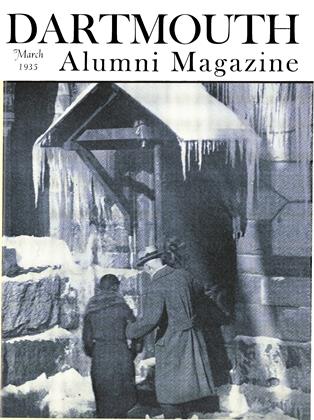IDENTIFICATION OF FIREARMS FROM AMMUNITION FIRED THEREIN—WITH AN ANALYSIS OF LEGAL AUTHORITIES
March 1935 C. J. Campbell '17IDENTIFICATION OF FIREARMS FROM AMMUNITION FIRED THEREIN—WITH AN ANALYSIS OF LEGAL AUTHORITIES C. J. Campbell '17 March 1935
By Jack D. Gunther '29 and Charles O. Gunther. John Wiley & Sons. 342 pages.
This book is the joint effort of a lawyer and an expert in firearms identification.
Approximately one third of the text is concerned with the scientific and technical aspect of firearms identification. Somewhat more than a third is given to the discussion of a single legal case in which the testimony of "ballistic. experts" played a profhinent part. The remainder of the book deals with a review and an analysis of cases involving the identification of firearms and projectiles.
In the first chapter, "The Principles of Firearms Identification from Ammunition Fired Therein," the authors outline the several types of problem which may be presented for solution. They then discuss with a wealth of illustrations the factors which enter into the solution of each problem, together with the apparatus and methods necessary. The subject is clearly and logically presented. The scientific investigator will find it a useful brief exposition. It should bring to the technician a knowledge of his limitations.
The second chapter deals with the SaccoVanzetti case. The testimony of the experts called is transcribed from the printed record of the case. Most of the testimony is given in toto. The relevent portions of the summary of counsel, the charge of the Court, the motions for a new trial with the accompanying affidavits and decision are given and discussed. Copies of photographs of important exhibits are included.
It was somewhat of a shock to read in the discussion that "The testimony given by the experts for the commonwealth was incompetent; . . . This statement is plucked from the text, not with the idea of presenting it for criticism but rather to indicate the trend of the discussion. The authors' opinion of the testimony put forward by the defense may be gleaned from the following: "The testimony of the experts for the defense was utterly incompetent: . . .
The third chapter, "Analysis of the Authorities on Firearms Identification," defines the attributes of the specially trained witness. Then follows a series of case histories and discussions with photographs of the bullets in evidence. Suggestions are given regarding the-presentation of evidence and the type of question useful in cross-examination in developing the qualification, or lack of qualification, of the expert witness. The future needs of the science of firearms identification are outlined.
There is a bibliography, an index, a table of contents, a list of illustrations, and a table of cases arranged by states. Footnotes indicate the source of the material ci ted.
 View Full Issue
View Full Issue
More From This Issue
-
 Article
ArticleGraven Laycock: A Dartmouth Tradition
March 1935 By C. E. W. '30 -
 Article
ArticleHANOVER BROWSING
March 1935 By Herbert F. West '22 -
 Class Notes
Class NotesClass of 1914
March 1935 By C. Edward Leech -
 Class Notes
Class NotesClass of 1918
March 1935 By Allan C. Gottschaldt -
 Article
ArticleTwenty-Five Years Ago
March 1935 By Hap Hinman '10 -
 Class Notes
Class NotesClass of 1934
March 1935 By Martin J. Dwyer Jr.
C. J. Campbell '17
Books
-
 Books
BooksQuestions on the Principles of Economics
January 1916 -
 Books
BooksTHE CADAVER OF GIDEON WYCK.
March 1934 -
 Books
BooksPINE LAKE.
MAY 1972 By ARTHUR M. WILSON -
 Books
BooksTHE MAGNIFICENT PARTNERSHIP.
March 1955 By E. BRADLEE WATSON '02 -
 Books
BooksTHE NORMAL CEREBRAL ANGIOGRAM,
January 1952 By HENRY L. HEYL, M.D -
 Books
BooksTHE FEAST OF QUAILS
June 1936 By W. H. Wood


